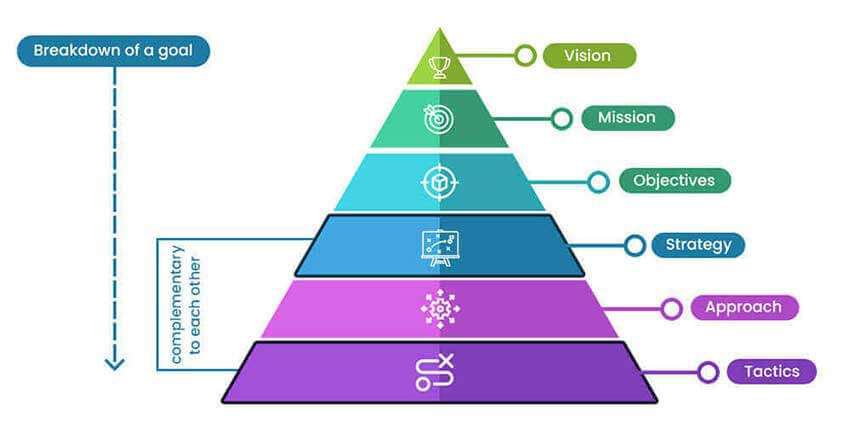"Good tactics can save even the worst strategy. Bad Tactics will destroy even the best strategy" - George S. Paton
Table of Content
Overview
Do you think that you have the astuteness, acumen, and agility to switch between being strategic and tactical? Do you think you have a clear comprehension of strategy versus tactics or do you believe that both these terms are rather interchangeable? Strategy and tactics are distinguishable fundamentals despite the cohesive correlation between the two.
In fact, if you have not acknowledged the difference between the two yet, you will be fascinated to discover how strategy stands apart from tactics. In this blog, we present to you a thoughtful, insightful, and intelligible explanation of strategy versus tactics, their contrast as well as their integration facilitated by a plethora of practical examples. Let’s see how our strategy to establish the understanding of strategy versus tactics works around various tactics! See, we already dropped a little hint!
What is a strategy?
What does it really mean to be strategic? We often come around terms like business strategies, corporate strategies, political strategies, stress management strategies etcetera. Would you rather use the term strategy for your short-term responses and goals or would you use this term in the bigger picture when we look at long-term objectives with massive implications? A strategy would always be the latter case.
Let us try to comprehend strategy in simple terms. You can very well say that a strategy is synonymous with long-term plans that are based on vision, clarity of purpose, critical thinking, and preferably with a contingency plan in place as well. Strategy is linked to a significant purpose that requires brainstorming, creative insights, careful assessment of different approaches and ultimately laying down a well-defined framework to accomplish the purpose.
In different contexts of life or in different industries, there may be little subjective differences in how people perceive the context of strategy. However, what remains identical in these slightly contrasting definitions of strategy is a prospective vision that is the inspiration behind long-term goals and missions that may be completed in months or years in a systematic and progressive manner. For better understanding and further elucidation, let us shed light on some examples of strategies across different contexts.
Here, it is noteworthy that there is a conceptual approach that is taken while evolving and framing strategies. To begin with, you first set a goal for yourself, your team, or your business organization. Moving forward, under the set goal, you define certain objectives that hold the key to the accomplishment of the goal in sight. Eventually, to meet the objectives and get the entire process streamlined, you then work on devising meticulous strategies backed by vision.
Exemplification of strategies
An example of a business strategy
Let’s take the example of Tesla here in times of the long strides that the electric vehicles industry is taking in the contemporary automobile industry. We all know that Tesla is headquartered in California and has an ever-increasing presence in the American automobile industry. But of course, Tesla would not want to limit itself to offering electric cars in only a few markets and will certainly have larger goals and objectives for revenue growth, penetrating emerging markets, enhancing brand engagement outside the US, and so on.

Talking of strategies linked to these objectives of revenue growth and building an international dominance, the company will be looking at strategies like expanding to countries like India. India not only offers a cost-efficient labor market to international manufacturers but also has a large number of car buyers, possibly looking for alternatives to petrol and diesel cars. Given that, the company can strategically work on an expansion strategy to meet its objectives. For that, the company will need to constantly analyze the macro environment in the industry. As for the objective of brand engagement, the company can formulate strategies like appointing Indian brand ambassadors for branding in India.
An example of an intergovernmental/diplomatic strategy

We are all aware of the latest political and social developments in Afghanistan where the Taliban, an Islamic radical fringe group has toppled the democratically elected government to establish a reign of terror. The pivotal goal of international organizations like the United Nations and multilateral partnerships like the G7 at this time will be to maintain peace and save the lives of civilians in Afghanistan. At the same time, one imperative goal of the international community will be to not let Afghanistan become another melting pot of global terrorism like Iraq and Syria.
The core strategy for international organizations and strategic multinational organizations from here would be to scale up collaborative efforts between countries. This will primarily include G7 nations (US, Canada, France, Italy, Japan, Germany, and the UK) and other top economies of the world like China and Russia which hold the great authority to influence global geopolitical developments. The crux of the strategy here will revolve around negotiations with the Taliban to give a safe passage to foreign nationals and ensure the security of the Afghan nationals.
What is a tactic?
After a comprehensive elucidation of the concept of strategy, now it will be easy to understand what tactics are. Do you remember we mentioned above that a strategy is an integration of multiple smaller objectives, actions, events, developments, and situational responses to successfully execute a strategy? That is exactly what tactics are!
Being tactical means having the life skill to handle complex situations and overcoming the challenges to meet smaller objectives that are salient to a larger plan or strategy. In other words, tactics are the building blocks of a strategy put together to streamline the execution of a strategy. When tactics are implemented correctly, strategies work really well and visions translate into reality.
That is how the Avengers defeated Thanos by putting a spectrum of tactics together to execute their ultimate strategy of bringing the war to an end by succeeding in their tactics. Their strategy was their ultimate game plan and how each Avenger discharged their individual roles as well as worked effectively in a cohesive team was tactically brilliant of them. We know you would love to keep talking about the Avengers but let’s look at some real-life examples of tactics.

Exemplification of tactics
An example of tactics: In continuation to Tesla’s expansion strategy
As mentioned above, to achieve its goal of revenue growth, expansion, and increased brand indulgence, Tesla will have to work on the strategy of entering markets like India. Next, to make this strategy worthwhile, the company will need to have a tactical approach and work on some key tactics.
One possible tactic here is that the company can design a new range of electric cars that are best suited for the Indian market based on buying preferences and the average disposable income of Indian customers. Moreover, to optimize sales in India, the company can plan its new launches around festive seasons like Diwali and offer attractive discounts and perks.
An example of tactics: In continuation to Afghanistan’s context
Now that the international community has identified the strategy to work on collaborative diplomatic efforts, multinational organizations need tactical brilliance. One good tactic for negotiating with the Taliban would be to nominate a few representatives from the international community to initiate dialogue with the Taliban.
Another tactic can be to threaten the Taliban with sanctions in case the Taliban initiates acts of terror. Moreover, preventing terror attacks in Afghanistan by gathering greater intelligence and sharing valuable information with other countries can also be a worthwhile tactic.
With these tactics, the international community will be able to engage in a meaningful dialogue with the Afghan government led by the Taliban. All of these feasible tactics will work in coherence with each other as well as the overall strategy of collaborative international efforts.
An example of strategy and tactics in the corporate world
As per Gallup, the cost of employee turnover for a business venture with around 100 employees and an average salary of $50,000 can be as high as $2.6 million per year. Having said that, businesses are always on the lookout for devising effective and worthwhile ways for boosting retention and bringing down attrition rates.
Thus, businesses define the imperative goal of bringing down employee turnover rates and hence prevent unprecedented financial losses because of high attrition. For this, one common strategy that business leaders undertake is to upscale the employee engagement levels in the workplace to promote greater commitment and loyalty.
Probing further, the success of the strategy of cultivating high employee engagement to pull down attrition rates will further depend on effective tactics. There can be multifarious tactics for driving high employee engagement including employee recognition, additional paid leaves, employee mentoring programs, virtual team building activities, promoting gratitude in the workplace, and so on. These tactics will correlate to each other and will determine the effectiveness of the strategy to boost employee engagement.
Strategy versus tactics
“A strategy is more synonymous with a long and purposeful journey while tactics are more like short trips”
You would have understood by now that strategy and tactics are complementary to each other and have a large degree of interdependence on each other. Various tactics integrate with each other and then eventually align to a strategic foresight to fulfill a large purpose. Speaking of what a large purpose looks like, there cannot be a better example in contemporary times than the shared purpose of the entire world at present to neutralize and eradicate the COVID-19 pandemic that has gripped the world for almost two years now inflicting daily casualties.
The goal at present amid the ongoing COVID-19 pandemic is to build herd immunity and prevent the spread of the virus to mitigate it completely. Further, the strategy is to immunize people and promote responsible behaviors among them to protect themselves and others from contracting the virus. Moving forward to tactics, the tactics include the vaccination programs launched by different countries, laws mandating masks in public places, and augmenting the production of alcohol-based sanitizers.
We hope you now have clarity on how strategy and tactic are different from each other yet so intrinsically connected. A strategy can be understood metaphorically as the framework for winning a test match in cricket. Speaking of tactics here, these will be the effective actions that teams would need to take to win every session in the test match.
A strategy is a roadmap to a long-term goal that serves as the foundation for establishing and assessing tactics. On the other hand, tactics are the best practices and actions that need to be in place for meeting the larger strategic objective.
Strategy and tactics integrate at various levels and in various magnitudes to achieve objectives that may be personal, community-based, organizational, national, or even international. Let us try to decipher the integration between strategy and tactic in an even more engaging and meticulous way through the following examples based on specific contexts.
Integration of strategy and tactics in healthcare objectives

As per the World Health Organization, in the first half of August 2021, Cote d’Ivoire has declared its first Ebola outbreak in 25 years or even more. We all know how fatal a virus Ebola is and as per the WHO, its fatality rate of the EVD virus is 50 percent which even goes up to 90 percent in some cases. Following the developments of the outbreak in Cote d’Ivoire, the country has initiated an immediate vaccination program for populations that are at high risk.
Hence, the strategy here is to run a well-managed and effective vaccination program for frontline workers and vulnerable sections of the population. The country has procured 2000 doses of vaccination by Merck and Guinea has supported Cote d’Ivoire by sending 3000 vaccine doses manufactured by Johnson and Johnson. Now to fulfill this strategy of vaccinating people against Ebola in high-risk areas will require the following tactics to be in place.
Possible tactics to make the Ebola vaccination program effective in Cote d’Ivoire
-
Ensuring easy availability of vaccines to all front line workers and sections prone to the outbreak.
-
Setting up online portals to book appointments for Ebola vaccination for an effective vaccination program.
-
Ensuring all safety protocols at vaccination centers to ensure they do not turn into Ebola hotspots.
-
Assuring an uninterrupted supply of Ebola vaccines, medicines, and other medical equipment by creating a robust supply chain needed to battle the Ebola virus.
-
Leveraging diplomatic ties and coordinating with the WHO for uninterrupted international support for the vaccination program and battling the outbreak of Ebola.
As you can see, the strategy of a worthwhile vaccination program needs a cluster of smaller objectives, policies, events, and developments to make a vaccination program successful.
Integration of strategy and tactics in a political campaign

Let us take the example of Germany here which goes into the general polls for choosing its next Vice-Chancellor on September 26, 2021. Angela Markel’s remarkable career as the leader of Germany for 16 years on the trot in a patriarchal world is coming to an end. As she prepares to step down from the center of Germany’s political stage, the opposition parties of the Christian Democratic Union, the current ruling party would be working aggressively on their political campaigns that would have already kickstarted.
Their strategy is as simple as winning a majority in the German Parliament known as Bundestag that has 709. As an era of the CDU comes to an end with Angela Markel voluntarily stepping down, opposition parties in Germany including the Christian Social Union, The Left Party, SPD, FDP, and others have a great chance of steering the CDU out of power. For that, they will need strong and strategic political campaigns that are intelligibly tactical at all levels.
Possible tactics for political campaigns that opposition parties in Germany can leverage.
-
Proactive social media campaigns to enhance engagement and to take party policies and core values among a maximum number of German nations.
-
Attracting the German conservatives with social media posts and dialogues on reinforcing the sentiment of German nationalism.
-
Creating appealing, interactive and extensive party manifestos offering perks and benefits to all sections of society with a vision for the future.
-
Tapping into the underachievements of the incumbent government to create anti-incumbency and highlighting the same via seminars, talks, and social media campaigns.
-
Winning the confidence of the intellectuals by presenting thoughtful post-COVID-19 economic recovery plans, plans to enhance the medical infrastructure, and pragmatic vaccination policies.
-
Engaging people of all ages by crowdfunding ideas and opinions for devising prospective policies for election manifestos.
As you can see, a strong political campaign needs to be both strategic and tactical while also exploring the relationship between the two and adapting to strategy versus tactics.
Integration of strategy and tactics in a business
Employee engagement is the latest buzzword in the new age corporate world and businesses are constantly looking to create business for fostering high employee engagement. As per Gallup, highly engaged teams can enhance the profitability of a business by 21 percent. Besides profitability, there are other multifaceted business benefits too because of which companies are keen on driving high engagement among their employees.
Among the various long terms strategies that HR managers and employers are working on for creating high performing and highly engaged workforce, creating a positive workplace culture is a widely used strategy. Now to make this strategy work effectively for the organization to achieve greater profitability and productivity via high engagement, the management needs to be tactical. The strategy of creating a positive and vibrant workplace environment will need the tactical inclusion of new dimensions in the workplace.
Possible tactics for creating positive workplace culture for facilitating high engagement
-
Initiating a tradition of employee recognition and rewards.
-
Giving perks to employees like Netflix subscription, gym memberships, shopping vouchers etcetera.
-
Offering flexibility and autonomy to employees to let them choose their working styles and tools at their convenience.
-
Conducting various team-building activities or virtual corporate games to promote greater trust-building and cordiality among team members.
-
Reinforcing the values of sustainability, empathy, gratitude, and collaboration in the workplace.
-
Offering employees the opportunity to take up freelancing jobs or work in a hybrid setup for a better work-life balance.
-
Extending emotional support and to remote workers.
-
Rendering learning and development as well as career advancement opportunities to employees.
-
Inclusion of employee wellness programs that focus on mental health as well as the overall well-being of the employees.
-
Celebrating diversity in the workplace.
It is quite visible here that for meeting the organizational objective of inspiring higher employee engagement for better growth, the strategy of creating a positive and vibrant workplace culture is salient. For that, the company needs to work on various tactics including smaller objectives, events, inclusions in the workplace, and so on. If you are further keen on acquiring a more comprehensive knowledge of strategic planning in corporate organizations, you should definitely read about the various strategic planning frameworks that are applied in the corporate domain.
Integration of strategy and tactics in negotiation

Negotiations make a common feature of life and we make several negotiations with people around us. From negotiation on business deals to negotiation on salaries and hikes, we come across different examples of negotiation around us on a daily basis. Let us try to understand the correlation between strategy and tactics through an example of a business deal.
Let’s say a large retail company in Finland is strategizing the acquisition of small food distribution companies in the nation for growing in stature and revenue. To implement its acquisition and mergers strategy for establishing itself as a monopoly, the food retail company has to be quite tactical to negotiate a mutually beneficial deal for all parties.
Possible tactics for negotiating a business deal for acquisitions and mergers
-
Sharing valuable information with stakeholders for transparency and trust-building.
-
Emphasizing more on the benefits that smaller parties will gain from the acquisition.
-
Explaining priorities in an upfront way and presenting them in a specific order of relevance and significance.
-
Making the first offer on price rather than letting the other party quote a price first.
-
Refraining from exhibiting any form of desperation for the need. Rather one must make it seem like the other parties need the acquisition more desperately.
-
Tapping on the weaknesses, vulnerabilities and financial instability of smaller companies.
-
Creating an effective pipeline of follow-up meetings.
-
Presenting detailed analysis like the prospects of growth, revenue increase, expected CAGR, and so on.
Clearly, the key to making the strategy of expansion through acquisition work, the key is to be tactical and implement the tactics in a smart way such that the acquisition seems more beneficial to the company being pitched for acquisition rather than the one wanting to acquire it.
How to measure strategies and tactics
The measurement and evaluation of the impact and implementation of strategies and tactics are as imperative as brainstorming them and devising them after critical research and development. Fo measuring the success of strategy and tactics, there can be different approaches based on different metrics for measurement.

Metrics for measuring strategies and tactics
Some of the metrics for measuring statistics and tactics can be financial or statistical. These will be based on numbers, percentages, data on revenues, profits, losses, cash flows, quarterly growth, compound annual growth rate (CAGR), and so on. That is how businesses and enterprises will measure the impact of their strategies and tactics. For instance, if they are investing in employee healthcare programs today, two to three years down the line, they would want to measure certain indicators. These indicators will include the reduction in employee healthcare costs, the decline in employee absenteeism rates, and the downfall in employee turnover costs. This will tell them if their strategies turned out to be worthwhile or not.
On similar lines, students will measure the impact of their academic strategies and tactics in terms of their grades in assignments and assessments. Besides, a person wanting to lose weight will measure the success of their diet and workout strategies in terms of the pounds shredded.
In addition to the statistical or numerical metrics for measuring strategies and tactics, there can also be some non-statistical indicators. These include productivity, operational efficiency, work efficiency, skill-building, confidence, learning, and so on.
For instance, let’s say an associate in a business organization aspires to promote to the managerial level within two years. For that, the executive will make a framework strategy with long-term goals and short terms goals. There will be an elaborative strategy to win the promotion facilitated by daily, weekly, and monthly goals along with other best practices that will make the tactics.
Let’s say based on the implementation of strategies and tactics related to skill-building, professional development, and continuous learning, the executive is able to bag a promotion. In that case, even without any real-time statistical indicators, the strategies and tactics will prove to be successful and worthwhile.
In the subsequent section, we look at some tips for measuring strategy and tactics. By incorporating these tips, one can effectively analyze the impact and success of strategies and tactics
Tips to measure strategy and tactics
1. Be particular about your strategic objectives: The basics of measuring strategy and tactics begin from clearly defining the strategic objectives the progress of which needs to be measured. Once the strategic objectives are clearly established, you will have clarity about what your principal goal is and you will get a precise idea of what indicators of strategic success you need to track
Here, critical thinking of the highest order will be quintessential. To illustrate, let’s say your strategic objective is to increase the annual profits of your business by 5 percent over the next two years. For this clearly defined strategic objective, there need to be clearly defined tactics as well and short goals like quarterly targets and the goals related to all indicators that drive profitability.
2. Choose the right metrics: After setting the strategic goals, you need to choose the metrics. To effectively measure strategies and tactics, it is imperative to choose only the right and pertinent metrics including the statistical and non-statistical ones subject to the objective. If you choose non-relevant metrics, the entire process of measurement will remain baffled with little clarity to offer.
3. Define relevant key performance indicators (KPIs): In order to measure strategy and tactics, one worthwhile and reliable way is to set certain key performance indicators. Key performance indicators give a measure of the progress that an individual, community, or organization is making in the pursuit of achieving the intended results. To add, KPIs give quantifiable measures that can be relied on for assessing the progression and efficacy of strategy and tactics. Let us try to understand KPIs better with some relevant examples.
Example of a KPI related to the COVID-19 response
As we know, all nations are battling the outbreak of the Novel Coronavirus, and almost all of them have initiated their vaccination drives. So, let’s say, as a part of the goal to optimize the response to the COVID-19 a country has set the objective of vaccinating 70 percent of its adult population within the next 4 months. Now, to measure if the ongoing strategies and tactics are aligned to the objective, KPIs such as daily vaccination rates and the number of adults vaccinated per week will be crucial.
Example of a KPI related to finance
Every business has the ultimate objective to grow its revenue on a year-on-year basis so as to scale new heights with every passing fiscal year. To measure the strategies and tactics undertaken by the company for revenue expansion, Budget revenue vs Actual revenue can be a useful KPI. This KPI is a quantifiable measure of the variance between the budgeted or expected revenue of a company for a fiscal year as compared to the actual revenue generated. This KPI is yielded by the formula-
| Budget Revenue vs Actual Revenue = | Actual Revenue - Budged Revenue x 100 |
| Budgeted Revenue |
Example of a KPI related to human resources
There are various KPIs that are used by HR managers to get a measure of the effectiveness of HR policies and other employee-related parameters in the company. One extensively used KPI in human resources is employee attrition or turnover rate. It is used to compute the success of a company in terms of retaining its employees as it depicts the number of employees quitting an organization in a specific time period. It is calculated using the following formula
| Employee attrition rate = | No. of employees leaving an organization in a specific period |
| Avg number of total employees in the corresponding period |
4. Having a data-driven approach: In this digital age, data is the ultimate king. Today, you can leverage technology in several ways to constantly maintain and upgrade the data related to various parameters linked to strategies and tactics. Data will give real-time insight into the impetus of progress driven by strategies and tactics. With a data-driven approach, you can create various graphs, infographics, and tables to measure and evaluate your strategies and tactics.
For instance, if you are working on strategies for effective time management, you can track your progress with various time tracking tools. These tools will give you an idea of how much time you are spending on each activity and how much time is actually needed on a certain task. In this way, you can use a time tracking tool to figure out if your time management strategies are rendering good results and increasing your productivity or not.
5. Documenting progress: While measuring strategies and tactics, it is also significant to document the progress and achievements on a daily or weekly basis. This will keep you informed about how strategies and tactics are getting along with each other and the larger goal you are pursuing. You can even maintain a journal for that.
6. Focus on the ROI: To measure strategies and tactics, you need to look at their return on investment. Here it is not necessary that the investment is in terms of money specifically. It can also be in terms of your time, effort, and persistence. Besides, here we are not necessarily talking about an ROI that comes in terms of percentages. Be quantifiably or in non-quantifiable terms, you need to evaluate how well your strategies and tactics have paid back.
To encapsulate, in layman terms, people would often say that strategy and tactics are synonymous with each other. However, on the other side of this blog, you now have a good idea of the differentiation as well as the integration between strategy and tactic. They go hand in hand and function along with each other despite not being identical to each other completely. Good and thoughtful tactics make strategies successful and vice versa. So, now that you are aware of what strategy versus tactics implies, you should surely be adding to the knowledge of others on the same!

